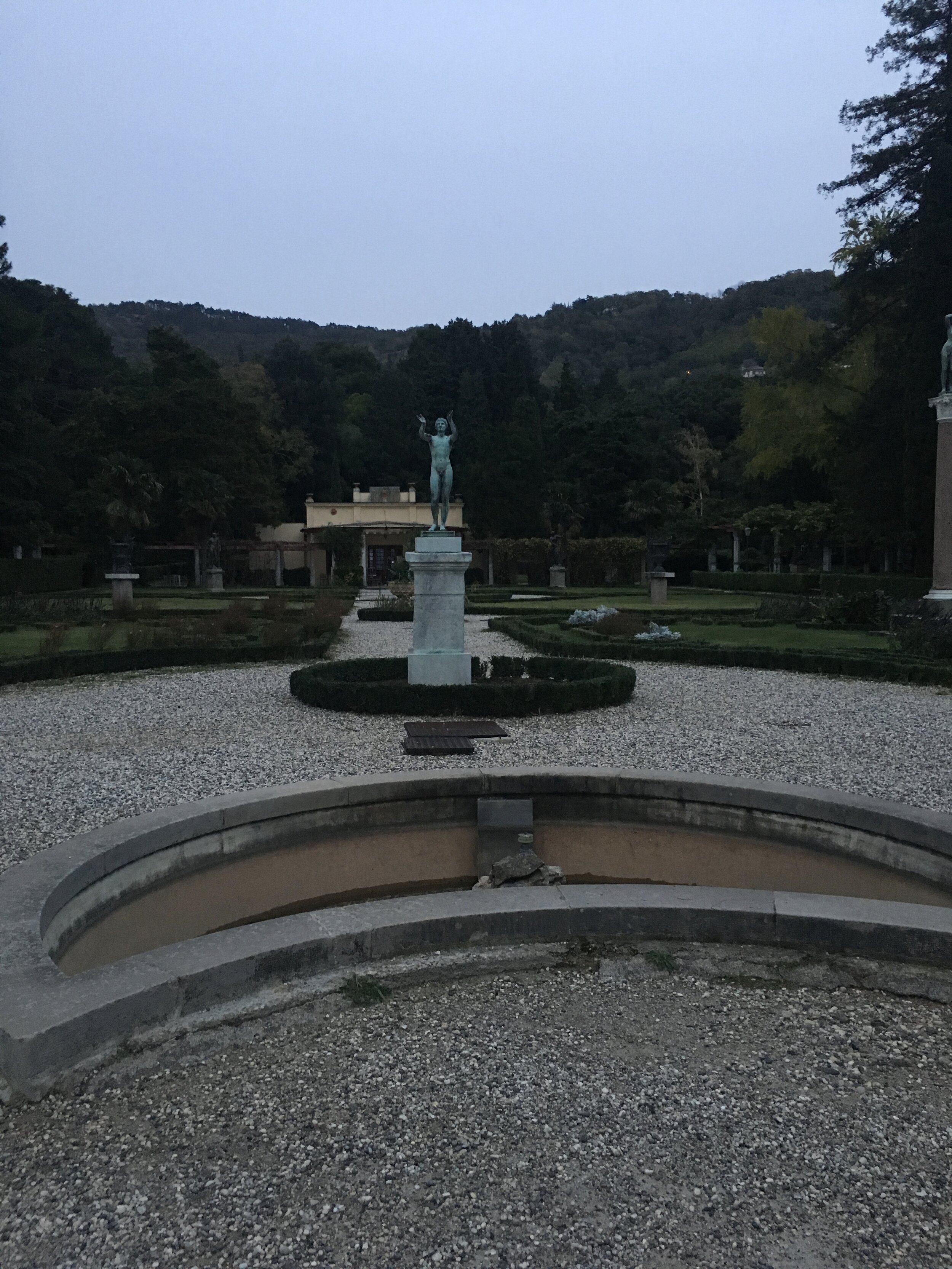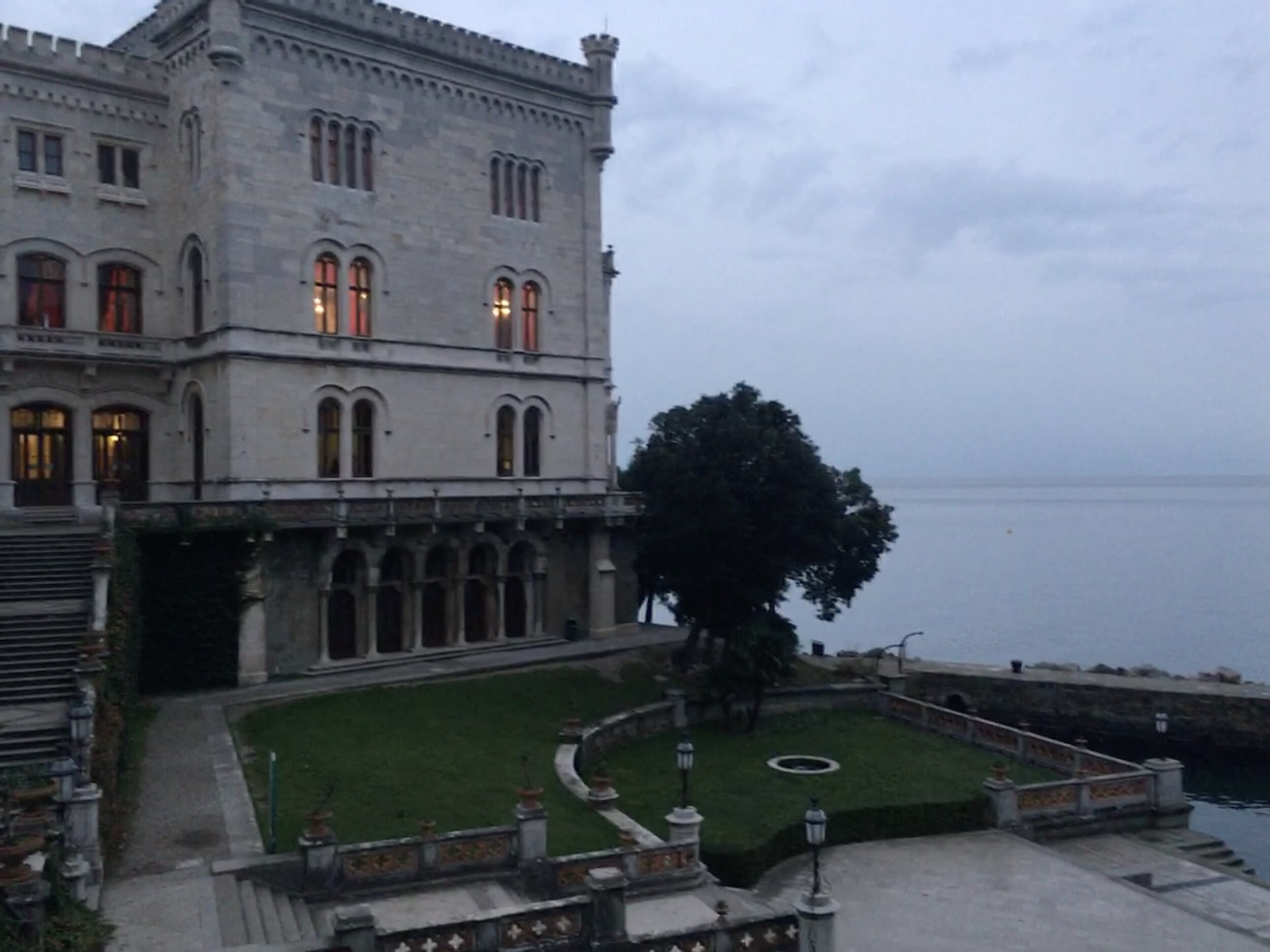Regional Features
Miramare Castle
On the official website, the castle is listed as the Museo Storico e il Parco del Castello di Miramare, and when you look at a map, the castle is surrounded by a very large green space denoting a park. We parked our car closer to the port area, and specifically near a Nautical Society which is marked in red on the map at right. Allow yourself time to explore the area in full, and be aware that park attendants do close the gates to the park before dark, and thus, before the castle is closed in the winter months. Plan your parking accordingly. We had to walk about 30 minutes back to our car, instead of 10 minutes because the park area was closed after we finished touring the castle. Miramare castle is located about 9 km north of Trieste. In fact, if you drive in from more central Italy, you will see it along the panoramic costal views before reaching Trieste.
Stroll through the surrounding park area. Archduke Ferdinand Maximilian of Habsburg, the proprietor of the castle and the grounds, was very invested in landscape around his lavish home. The area of 22 hectares was planned by Carl Junker, and the park was intended to be “an experimental centre for reforestation and the acclimatisation of rare botanic species,” according to the official website. Interestingly, the area of the Grignano promontory was quite rocky and devoid of any vegetation. The technical description often used is karst, which is a topographical feature of the larger area (hence the caves described below). Plots of soil, trees and shrubbery were imported, planted, and they miraculously transformed the area. The grounds are still carefully maintained in the Archduke’s memory well over 150 years later.
Explore the history inside the castle. Admission is 10 euros, but the historical information provided throughout the rooms is thorough. As mentioned, the Archduke Maximilian of Hapsburg commissioned this castle around 1855. Maximilian was brother of Emperor Franz Joseph, and he desired a grand residence in the vicinity of Trieste that was worthy of the heavy ‘Hapsburg’ family name. The interior decoration is lavish, and I know you will enjoy exploring the rooms on the upper and lower floors. Interestingly, Archduke Maximilian and his wife Charlotte of Belgium inhabited the castle home for only four years before they left for Mexico, where Maximilian strangely was crowned emperor in 1864, but was executed by a firing squad in 1867. (Not where you thought this narrative was going? Ha! Me neither…) Thus, the Austrian emperor of Mexico sadly never returned to his beloved Miramare.
Photograph the views from outside and inside. There are some wonderful vistas through the windows of the castle. We visited as sunset faded into twilight, and the blues of the vast Adriatic complimented the castle walls. You will also want to explore the grounds, down by the waterfront. The coastline stretches long in both directions and you can admire the port city of Trieste in the distance. Once a part of the powerful Austrian empire, this Hapsburg castle remains an ostentatious reminder of the complex cultural history in the region of Friuli Venezia Giulia.
Postumia (Postojna) Cave and Predjama Castle
To visit this regional feature, you will need to cross the border into the country of Slovenia. As mentioned in the Introduction, the Slovenian border is located less than 20 minutes from Trieste. On a practical note, you also need to purchase a so-called ‘vignette’ which is like a toll pass, if you are driving from Italy to Slovenia. You can purchase one for about 15 euro at a gas station near the border. Find out more on this website. Enjoy the scenery on the drive, that is, after purchasing your ‘vignette’ so that you do not have to worry about fines. Take in the truly gorgeous landscapes in Slovenia. The country is becoming famous for natural wonders such as Lake Bled and regional/national parks. If you are just taking a day trip from Trieste, like we did, you will still be able to enjoy the greenery that surrounds on the 40 minute drive to Postumia, even though there is much more countryside to explore if you drive further in towards to capital of Lubiana.
Train through the caves at Postumia. The area is believed to have been populated since the paleolithic era, and it is most famous for the elaborate cave system. In fact, the caves were created over millions of years by the Pivka River. When I visited, there was an idyllic view of the river from outside the entrance to the caves with patches of snow on the ground near the rushing river. The area is considered a ‘cave park’ and there are a few restaurants and even a hotel in the complex. Personally, I don’t think you need more than a few hours here; however, I was truly glad that I took this time for an experience that is rather anomalous in my travel patterns. I do like to experience nature especially through hiking. This experience was more scientific.
First of all, you board a ‘train’ to shuttle you through 15 miles of stalagmites, stalactites, and rock formations that seem to have sprung from Salvador Dali’s imagination. Personally, I have never seen a cave quite like this, and I was in awe. The tour is well-organized with a guide for each group organized by language. After flying through miles of incredible natural sculpture, you disembark and walk with the guide through further cavernous passageways.
The Postojna Cave system is the second longest in the country after the Migovec System, which speaks to the speleological richness in the country of Slovenia. The area is known specifically for the topography of karst, which provides the perfect conditions for cavern creations. You can purchase tickets online ahead of time here. I was pleased to bolster my scientific knowledge of cave systems, but the natural phenomenon is so powerful to see in such abundance, there is also a rather spiritual quality to the place, certainly an otherworldly, uncanny, beauty.
Relish views of the Predjama castle. You can also buy a combined ticket (Postumia caves and Predjama castle) in order to tour the inside of the Predjama castle. We opted to only admire it from the outside. The two attractions are located only 10 km apart, about a 13 minute drive. I read that during July and August there is a free shuttle between the two sites for combined ticket holders. We hopped in the car and drove more scenic Slovenian roads until we reached the striking castle within the rocks. Parking is easy and free, and we walked down a short hill until the amazing sight came into view. It is listed as one of the Guinness World Records for the world’s largest cave castle, and again, the incredible karst rich topography allowed for its construction into the rock face. It is medieval in origin, built from the year 1202, but according to Lonely Planet: “most of what you see today is from the 16th century.” There are tales of intrigue associated with the castle, and you can read more about the legend of Erazem Lueger here.
Eat at Gostilna Pozar. Instead of rushing to tour the castle, we opted for a hearty local lunch with a gorgeous view through the windows of the cozy Gostilna Pozar restaurant. The atmosphere was cozy; we drank the most popular Slovenian beer, Lasko (now a part of the Heineken company). Go for one of the house specialities of čevapčič, which is grilled minced meat, considered a popular regional dish in many of the Balkan countries. Goulash (Bograč) is also traditional and popular in Slovenia, and this is what I had. It was delicious comfort food on a chilly day.









